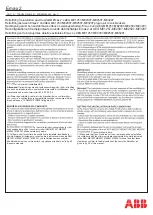
44
Power supply replacement
The electronic controller power supply is
suitable for input voltages for the high
range of 95-250 Vdc or 85-265 Vac, and for
the low range 28-56 Vdc.
1. Remove the front cover of the operator
housing.
2. Use appropriate procedures to prevent
electrostatic discharges.
3. Unplug the connector (105.2) from the
bottom of the controller board and wait
for the red LED on each capacitor board
to stop blinking. This indicates discharge
of the capacitors to a low voltage. Do
not unplug connector (106.3) from the
capacitor boards, or damage to the
capacitor board or the controller board
may occur.
4. Mark the wires so that they can be
reinstalled to the correct terminals.
5. Remove the wires from the power
supply.
6. Disconnect the power supply from the
DIN-rail by pushing down on the latch
on the rear top surface of the power
supply.
7. Install the replacement power supply by
snapping it onto the DIN-rail.
8. Reinstall the wires to the power supply.
When work is finished, operate circuit
breaker and close and open several times,
and check that all screw connections are
tight. Refer to “Installation checks and
functional tests” on pages 6-9.
Replacement of vacuum interrupters
Replacement vacuum interrupters are
furnished as a complete assembly. They
have been completely tested and
dielectrically and mechanically conditioned.
It is recommended that one vacuum
interrupter be removed and replaced
completely rather than removing two or
more vacuum interrupters at a time.
The following procedure in check list format
describes the procedure for removing and
replacing a vacuum interrupter. Components
may be identified by reference to Figure 24:
Vacuum interrupter replacement illustration
on page 46 and Figure 25: Illustration
showing required technique for fastening
terminal-clamp hardware on page 47.
Instructions herein apply for replacement of
all vacuum interrupters except vacuum
interrupters on 3,000 A circuit breakers
having the flexible connector (refer to 29.1
in Figure 24: Vacuum interrupter
replacement illustration on page 46)
electron-beam welded to the moving
terminal (refer to 36.1 in Figure 24: Vacuum
interrupter replacement illustration on page
46) of the vacuum interrupter. These
interrupters must be replaced by factory-
trained personnel. Contact Siemens
medium-voltage customer service at +1
(800) 347-6659 or +1 (919) 365-2200
outside the U.S.
1. Removing the vacuum interrupter
Note:
Special care needs to be exercised in
removal or installation of hardware around
the movable contact end of the vacuum
interrupter.
The movable contact uses a metal bellows
to maintain the vacuum seal while still
permitting motion of the contact along the
axis of a vacuum interrupter. The bellows is
rugged and reliable, and is designed to
withstand years of axial movement.
However, care should be exercised to avoid
subjecting the bellows to excessive torque
during removal and replacement. Twisting
the bellows through careless bolt removal or
tightening may damage the vacuum
interrupter, resulting in loss of vacuum
integrity.
1.1 Before starting work, the circuit
breaker should be isolated from all
primary and control power sources.
Make sure that the capacitors are
discharged by unplugging connector
105.2 from the controller board.
Discharge any static charge by
grounding both ends and the middle of
each vacuum interrupter. Carefully
remove phase barriers (if present).
1.2 Loosen the lateral bolt(s) on terminal
clamp (29.2). Employ the illustrated
procedure to loosen clamp hardware
(refer to Figure 25: Illustration showing
required technique for fastening
terminal-clamp hardware on page 47).
1.3 Withdraw pin (48.5) from insulating
coupler (48.0) and levers (48.6).
1.4 Remove coupling pin from the eye bolt
(36.3).
Figure 23: Power supply
replacement
104.0
Item
Description
104.0
Power supply
NOTICE
Capacitor discharge plug (105.2)
Disconnect control power prior to
removing or replacing the
capacitor discharge plug. Refer to
Figure 2 on page 7.
To discharge capacitors:
Disconnect control power to
the circuit breaker by opening
the disconnect device (device
08 in the typical schematic in
Figure 14 on page 24) located
in the control compartment.
After control power is off,
disconnect the capacitor
discharge plug (105.2) from
the controller board (105.0) to
discharge capacitors.
To reconnect capacitors:
Disconnect control power to
the circuit breaker by opening
the disconnect (device 08 in
the typical schematic in Figure
14 on page 24) located in the
control compartment.
Insert the capacitor discharge
plug (105.2) (with six pins)
into the left-hand receptacle
on the controller board
(105.0). Ensure that the plug is
properly seated and the plug
position is level with the power
supply connection plug
(105.5) that is located to the
right of the capacitor discharge
plug.
After the capacitor discharge
plug is firmly seated, reconnect
control power to the circuit
breaker (device 08 in the
typical schematic in Figure 14
on page 24).































